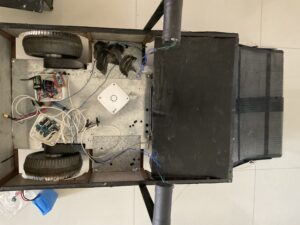Aryan Gupta, a young innovator and robotics enthusiast, has developed a groundbreaking solution to address one of India’s most pressing urban sanitation issues: clogged open sewers. His creation, the “Clogtopus” rover, is an autonomous machine designed to clean sewer systems, eliminating the need for hazardous manual scavenging. Gupta’s journey from school projects to real-world applications is a testament to the potential of robotics in solving global challenges.
Passion for Problem-Solving
Gupta’s interest in robotics began early, sparked by school projects that involved building machines using Arduino and EV3. “I have always been interested in building and designing machines that solve practical problems,” Gupta explains. His hands-on experiences, from mechanical design to automation, helped him refine his skills and ultimately led him to focus on waste management solutions. “Over time, I wanted to apply these skills to real-world social challenges rather than just competitions or prototypes.”
The Inspiration Behind Clogtopus
The inspiration for the Clogtopus rover came from a deep concern for India’s open sewer systems, which are notorious for causing waterlogging, disease, and the need for manual scavenging. “Open sewers are a serious issue in many parts of India,” says Gupta. “I noticed how often these drains remain blocked because of poor accessibility and unsafe cleaning methods.” He saw an opportunity to combine his engineering expertise with a pressing social cause: improving public sanitation and enhancing human dignity.

‘Clogtopus’ Rover.
The Design Process
The design of the Clogtopus rover began with sketches and CAD models on Onshape. Gupta tested different waste removal mechanisms before settling on a mesh loader bucket inspired by excavators. Arduino technology played a crucial role in the development, controlling the rover’s motor system to manage the bucket’s lift and release. “Arduino helped me quickly prototype and refine the movement using simple and effective programming,” Gupta says.
Overcoming Challenges
Building the rover presented several challenges. One major obstacle was waterproofing the electronics and motors, as the rover would be used in high-moisture environments like sewers. Gupta tackled this by conducting simulated tests in mud and water-filled columns to identify weak points. “These tests made the rover more durable and ready for real-world use,” he notes. Reinforced materials were used to strengthen the rover’s body, ensuring it could handle the mechanical stress involved in lifting heavy waste.
Key Features of the Clogtopus Rover
The Clogtopus rover is designed to scoop out solid waste that blocks water flow in sewers. Its mesh loader bucket allows water to pass through while trapping solid waste inside. The rover uses two DC motors to lift and release the waste, reducing human contact with dangerous materials. Gupta explains, “Once the waste is collected, it can be lifted out for disposal, which reduces human contact.”
3D Printing for Prototyping
3D printing played a pivotal role in the project, particularly during the prototyping and testing phases. Gupta explains that it allowed him to quickly create and modify parts, such as the bucket and frame, reducing both cost and time. “This method also helped cut down on material waste during the development phase,” he adds.
Advanced Sensors for Future Models
Future versions of the rover will incorporate advanced sensors, including ultrasonic sensors to detect obstacles, pH sensors to monitor sewer conditions, and cameras to locate potential clogging spots. “These additions will make the rover partially automated and improve data collection for maintenance,” Gupta says.
Impact and Future Plans
While the Clogtopus rover has not yet been deployed in public sewer systems, simulated testing has shown its potential to remove solid waste while maintaining water flow. Gupta’s next step is to collaborate with local sanitation authorities for pilot testing. “My long-term goal is to create a modular system that can adapt to different types of drains and environments,” he shares. He also hopes to present the rover to government innovation programs for broader implementation.
Addressing Manual Scavenging
Gupta’s work addresses the critical issue of manual scavenging, a dangerous and degrading practice still prevalent in many parts of India. “The Clogtopus aims to reduce the need for human entry into drains by automating the cleaning process,” Gupta explains. This technology, he believes, can improve safety while restoring dignity to sanitation workers.
Collaboration with Dr. Zaynah Dhunny
Gupta’s research on robotics has attracted attention from prominent figures in the field, including Dr. Zaynah Dhunny, a Nobel laureate. The two collaborated on a research paper exploring how robots, like Gupta’s rover, can be used to solve social challenges. Gupta reflects, “Our paper studied global examples of socially impactful robotics and discussed the ethical aspects of automating human labor.”
Advice for Aspiring Innovators
Gupta offers valuable advice to young innovators looking to make a difference through technology: “Start with a problem that truly matters to you. Use any resources you have, even basic tools like Arduino or 3D printing, to start building early. Innovation should always focus on helping people and improving their quality of life.”
Aryan Gupta’s work with the Clogtopus rover exemplifies the power of technology to address societal challenges. By applying his skills in robotics to solve real-world problems, Gupta has shown that innovation can go beyond the lab and make a tangible difference in improving public health and sanitation. His journey serves as an inspiration for young innovators everywhere to leverage technology for social good.

